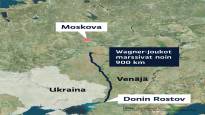The leader of the Wagner group responsible for the rebellion is sent to Belarus.
Joonatan Reunanen,
Idalotta Nousiainen,
Maija Hurme
On Midsummer’s Eve, Wagner’s director Yevgeny Prigozhin claimed that Russia has attacked the Wagner forces. This gave the impetus to the rebellion, which eventually failed.
PMC Wagner (Wagner Private Military Company), or Wagner for short, is a mercenary group consisting of about 25,000 fighters, which was founded in 2014. The leader of the group is Yevgeny Prigozhin, also known as “Putin’s cook”.
Wagner forces have participated in conflicts at least in the Middle East and Africa, often fighting alongside Russian government forces.
Friday evening 23.6. Wagner moves to Russia
Prigozhin claims that Russia has attacked Wagner’s fighters with missiles. The Russian Ministry of Defense denies the attack and calls the claims lies and provocation.
Saturday morning 24.6. Wagner captures the southern command headquarters of the Russian army
Wagner forces capture the southern command headquarters of the Russian army in Rostov-on-Don. Headquarters is responsible for the war of aggression in Ukraine.
Rostov-on-Don is a large port city just a two-hour drive from the occupied territories of eastern Ukraine. The bases of the Wagner forces were located in the occupied territories.
Morning 24.6. A convoy of about 5,000 soldiers is advancing along the highway towards Moscow
A convoy of about 5,000 Wagner soldiers advances along the M4 highway towards Moscow.
Noon 24.6 The Russian army and Wagner face off. Wagner seizes strategic targets in Voronezh
The Russian army tries to stop the convoy, but the Wagner forces destroy some of the Russian army helicopters.
In the vicinity of Voronezh, the Russian army, on the other hand, fires on Wagner’s troops and sets fire to a fuel warehouse in order to hinder the progress of the rebels. The city is home to a Russian military air base.
After the meeting, the Wagner forces continue their journey towards Moscow.
Afternoon 24.6. Wagner arrives in Lipetsk, where the Russian military air base is located.
Wagner arrives in the Lipetsk region, about 400 kilometers from Moscow. An air base of the Russian army is located in Lipetskin.
Afternoon 24.6. The Oka river as the capital’s defense line
Moscow prepares for an armed conflict and the Oka river becomes the capital’s defense line. Efforts are being made to stop the troops, for example, by digging up highways.
Evening 24.6. The Wagner forces are withdrawn
On Saturday evening, Prigozhin stops his journey 200 kilometers before Moscow and withdraws his troops. At eight o’clock in the evening, Prigozhin announces that his troops will no longer head towards the capital. He cites, among other things, the avoidance of unnecessary bloodshed as the reason. There is no exact information on the current location of the troops.
Russia first announced that it would drop charges against Prigozhin, but he would be sent to Belarus, and some of the Wagner mercenaries would be attached to the Ministry of Defense. On Monday, it was reported that Wagner’s manager is still under criminal investigation.
Sources: , Financial Times, BBC, The Guardian, The Combating Terrorism Center of the US Military Academy
What thoughts did the story evoke? You can discuss the topic until 23:00 on June 27.
